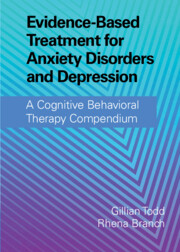 Evidence-Based Treatment for Anxiety Disorders and Depression
Evidence-Based Treatment for Anxiety Disorders and Depression Book contents
- Evidence-Based Treatment for Anxiety Disorders and Depression
- Evidence-Based Treatment for Anxiety Disorders and Depression
- Copyright page
- Contents
- Figures
- Tables
- Contributors
- 1 Introduction
- 2 The History and Philosophical Underpinnings of CBT:
- Part One Cognitive Behavioral Therapy for Anxiety Disorders
- Part Two Cognitive Behavioral Therapy for Posttraumatic Stress Disorder
- Part Three Cognitive Behavioral Therapy for Obsessive-Compulsive Disorder and Associated Disorders
- 11 Obsessive-Compulsive Disorder:
- 12 CBT for OCD:
- 13 Obsessive Compulsive Disorder:
- 14 Other Specified and Unspecified Obsessive-Compulsive and Related Disorders
- 15 A Cognitive Behavioral Approach to Body Dysmorphic Disorder:
- 16 Comprehensive Behavioral Treatment for Trichotillomania (Hair Pulling Disorder) and Excoriation (Skin Picking) Disorder
- 17 Cognitive Behavioral Therapy for Hoarding Disorder
- Part Four Cognitive Behavioral Therapy for Depression
- Part Five Complexity and Comorbidity in Anxiety Disorders and Depression:
- Part Six Specialist Applications of Cognitive Behavioral Therapy for Anxiety Disorders and Depression
- Part Seven Future Developments
- Appendices
- Index
- References
13 - Obsessive Compulsive Disorder:
Treating Obsessions and Associated Behavioral Responses
from Part Three - Cognitive Behavioral Therapy for Obsessive-Compulsive Disorder and Associated Disorders
Published online by Cambridge University Press: 06 January 2022
- Evidence-Based Treatment for Anxiety Disorders and Depression
- Evidence-Based Treatment for Anxiety Disorders and Depression
- Copyright page
- Contents
- Figures
- Tables
- Contributors
- 1 Introduction
- 2 The History and Philosophical Underpinnings of CBT:
- Part One Cognitive Behavioral Therapy for Anxiety Disorders
- Part Two Cognitive Behavioral Therapy for Posttraumatic Stress Disorder
- Part Three Cognitive Behavioral Therapy for Obsessive-Compulsive Disorder and Associated Disorders
- 11 Obsessive-Compulsive Disorder:
- 12 CBT for OCD:
- 13 Obsessive Compulsive Disorder:
- 14 Other Specified and Unspecified Obsessive-Compulsive and Related Disorders
- 15 A Cognitive Behavioral Approach to Body Dysmorphic Disorder:
- 16 Comprehensive Behavioral Treatment for Trichotillomania (Hair Pulling Disorder) and Excoriation (Skin Picking) Disorder
- 17 Cognitive Behavioral Therapy for Hoarding Disorder
- Part Four Cognitive Behavioral Therapy for Depression
- Part Five Complexity and Comorbidity in Anxiety Disorders and Depression:
- Part Six Specialist Applications of Cognitive Behavioral Therapy for Anxiety Disorders and Depression
- Part Seven Future Developments
- Appendices
- Index
- References
Summary
“Pure” obsessions were once considered untreatable. This chapter provides clarity on the definition of obsessive thoughts and their associated behavioral sequelae (mental and physical rituals, reassurance seeking, and avoidance). The reader will become familiar with the universality of intrusive thoughts and the mechanism by which they convert to obsessive thoughts in certain individuals. The most common misinterpretations of obsessive thoughts are outlined (including fears that one is crazy, immoral, and/or dangerous). Up-to-date research on evidence-based treatment for this symptom is reviewed. Structured assessment tools and options for open-ended questions are provided for measuring not only symptoms, but the maladaptive beliefs associated with these symptoms. A case vignette of a new mother who began having intrusive thoughts of harming her infant is used to illustrate the case formulation, as well as behavioral and cognitive interventions. The chapter ends with relapse prevention strategies and suggested further reading.
Keywords
- Type
- Chapter
- Information
- Evidence-Based Treatment for Anxiety Disorders and DepressionA Cognitive Behavioral Therapy Compendium, pp. 252 - 268Publisher: Cambridge University PressPrint publication year: 2022
